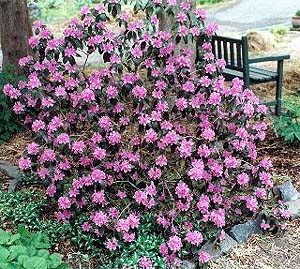RENEGADE GARDENER™
The lone voice of horticultural reason
Rhododendron ‘PJM’
(Row-doe-DEN-drun)
 She’s a beauty. Pictured is the oldest and largest PJM in my garden, a ten-year-old that tops out at just over five feet. The photo is from last spring. This is what she’ll look like again in two to three weeks. (Sorry, but when a plant is beautiful, I automatically refer to it as a she; sexist, I know.)
She’s a beauty. Pictured is the oldest and largest PJM in my garden, a ten-year-old that tops out at just over five feet. The photo is from last spring. This is what she’ll look like again in two to three weeks. (Sorry, but when a plant is beautiful, I automatically refer to it as a she; sexist, I know.)
I have three more up by the bay window in my front yard, four-year-olds that are around three feet high, and they do a nice job of knocking your socks off from the street. What a plant.
PJM is the hardiest of the many varieties of “Rhodies” that can be grown in the north, with bud tolerance to 25°-below zero. I think I did a little better than that one year, but mine grow in a somewhat protected area. They are one of the few broad-leafed evergreens available to northern gardeners, meaning they have leaves that do not die and drop in the winter. The PJM is particularly beautiful year-round, its dull-green leaves turning purplish in the fall.
Care and Use
Ah, yes. Successfully growing Rhodies involves some prep and maintenance. The Home Depots of the world sell a million of these things each May, when they are offered for sale in two- and three-gallon pots while in brilliant bloom. People snatch them up by the Taurus backseat-load. But I’ve always felt each plant should have a big tag that reads, “WARNING: Growing This Thing Involves Gardening.” Because what happens is most homeowners take them home, stick them in clay, don’t water them, and they die. To quote my ten-year-old, “Duh!”
Rhododendrons need to grow in an acid, moist, light, well-drained soil with a pH between 4.5 and 6.5. In other words, if ever there was time you need to prepare the soil, this is it.
Nearly all Rhododendrons grow and bloom best in shade to partial shade, which is why I love them. The one pictured will hit six-feet, about the tallest you can coax any Rhodie in the north. Rather than waste any more space here, refer to my column Growing Rhododendrons and Azaleas.
Don Engebretson
The Renegade Gardener